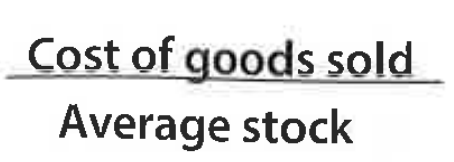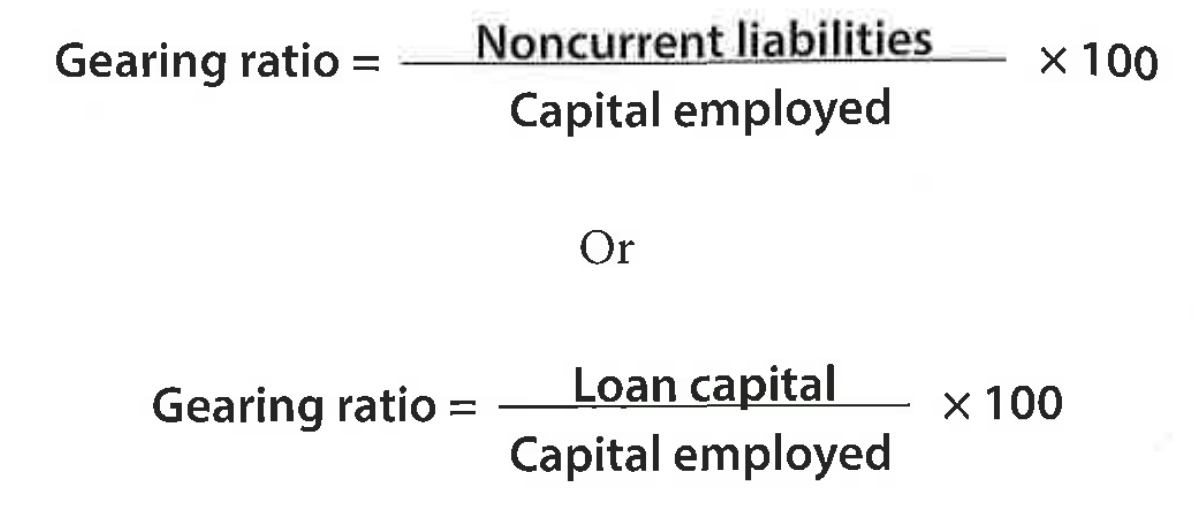3.6 Debt/Equity ratio analysis
1/75
There's no tags or description
Looks like no tags are added yet.
Name | Mastery | Learn | Test | Matching | Spaced |
|---|
No study sessions yet.
76 Terms
Debt and equity ratios (aka efficiency ratios)
Enable a business to calculate the value of their liabilities + debts against their equity
These ratios are a measure of the financial stability of the business
4 efficiency ratios
Stock turnover
Debtor days
Creditor days
Gearing ratio
Stock turnover ratio (inventory turnover)
Measures:
the no. of times a business sells its stocks within a year
OR the avg no. of days it takes for a business to sell all of its inventory.
How can stock turnover ratio be expressed?
No. of times a business sells its stocks within 1 year
Avg no. of days for a business to sell all of its inventory
What does the stock turnover ratio indicate?
The speed at which a business sells + replenishes all its stock
Stock turnover ratio equation
(no. of times)
Cost of sales / average stock

Stock turnover ratio equation
(no. of days)
(Average stock / cost of sales) x 365

For stock turnover ratio, is cost of sales or sales turnover used + why?
Cost of sales (COGS)
Bc stocks are valued at the cost value of the inventory to the business rather than the selling price to the customer
Calculate stock turnover ratio for:
$100,000 cost of sales
$20,000 average stock level
100 000 / 20 000 = 5 times
(20 000 / 100 000) x 365 = 73 days
Benchmark for stock turnover
No. of times = higher the better
No. of days = lower the better
BUT diff businesses = diff ST benchmark figures
So compare similar businesses only
Eg restaurant much higher ST ratio than luxury vehicle seller
Reasons for stock turnover benchmark
Higher the better for no. of times
Lower the better for no. of days
More stock sold → business more efficient in generating profit
Perishable stocks don’t expire / become outdated
General way to improve stock turnover ratio
Reduce organization’s stock level
Strategies to improve stock turnover ratio
Hold lower stock levels → inventories need to be replenished more regularly
Divestment (disposal) of slow selling stock (obsolete / unpopular)
Reduce range of products being stocked → only keep best selling products
Debtor days ratio
An efficiency ratio that measures the average no. of days it takes for a business to collect the money owed from debtors
Debtors
Customers who have purchased items on trade credit → owe money to the business
Is creditor days or debtor days more important?
Debtor days
Debtor days ratio equation
(Debtors / total sales revenue) x 365
TSR = approximation of firms total credit sales

Benchmark for debtor days
Lower the better
Lesser time it takes for customers to pay their debts = better
Why is the benchmark for debtor days the lower the better?
Improves cash flow of business
Bc of opportunity cost of holding onto money → business can invest this money in other revenue-generating projects
If a debtor days ratio is too high, why is this problematic?
Too long credit period granted → business faces liquidity problems
If a debtor days ratio is too low, why is this problematic?
Uncompetitive credit period → customers seek other suppliers bc clients prefer better credit terms
Credit control
The ability of a business to collect its debts within a suitable timeframe
Benchmark for debtor days for a healthy business
30-60 days
General way to improve debtor days
Reduce debt collection period
Strategies to improve debtor days
Impose surcharges on late payers
Give debtors incentives to pay earlier
Refuse further business with clients until payments are made
Threaten legal action
For which businesses is it acceptable to have a higher debt collection period + why?
Suppliers of expensive luxury goods
Bc rely more on credit sales
Creditor days ratio
An efficiency ratio that measures the average no. of days it takes for a business to pay its creditors
Creditor days equation
(Creditors / cost of goods sold) x 365
Cost of sales = approximation of firm’s total credit purchases

Calculate creditor days:
$225 000 owed to suppliers
$2 000 000 COGS
(225 000 / 2 000 000) x 365 = 41 days
On avg, business takes 41 days to pay its suppliers
CD ratio acceptable, bc most businesses provide 30-60 days credit period to customers
Benchmark for creditor days ratio
Lower the better
Why is a lower creditor days ratio the better?
Business avoids late payment penalties to trade creditors
Pros of high creditor days ratio
Repayments are prolonged → helps free up cash in the business for other use (in ST)
Cons of high creditor days ratio
Business taking too long to pay trade creditors → suppliers impose financial penalities for late payments → harms firms cash flow position
add
add
Strategies to improve creditor days
Improve debtor days → collect enough cash to pay creditors
Negotiate longer TC terms (if struggling bc of too long working capital cycle)
Ideal combination of creditor days ratio + debtor days ratio
High CD
Low DD
Enhance efficiency position of business by…
Improving any of its efficiency ratios
Increase stock turnover
Reduce debtor days
Increase creditor days
General- strategies to improve efficiency position of a business
Develop closer relationships with customers, suppliers, creditors
Introduce JIT production
Improve credit control
General strategies to improve efficiency position of a business
Develop closer relationships with customers, suppliers, creditors
Helps reduce debt collection time + extent credit period
Introduce JIT production
Eliminates need to hold large amounts of stock + improves stock control
Improve credit control
Manage risks regarding amount of credit given to debtors
How does developing closer relationships with customers, suppliers, creditors improve the efficency position of a business?
Helps:
Reduce debt collection time
Extend credit period
How does introducing JIT production improve the efficiency position of a business?
Eliminates need to hold large amounts of stock
Improves stock control
Gearing ratio
Measures the percentage of an organization's capital employed that comes from external sources (NCL)
Eg mortgages
What does the gearing ratio assess?
Firm's LT liquidity position
2 equations for gearing ratio
(NCL / capital employed) x 100
(Loan capital / capital employed) x 100

Capital employed equation
Non current liabilities + equity
Equity equation
Share capital + retained earnings
What does it mean the higher a firms gearing ratio is…
The larger the firm’s dependence on LT sources of borrowing
Highly geared firm
Gearing ratio of 50% or above
Cons of high gearing ratio
Business incurs higher costs due to debt financing (interest repayments) → limits profit
Vulnerable to increases in interest rates
Difficult to seek external SoF from other financiers
Downturn in economy / recession → loan repayments remain high but cash inflow from sales fall
If a firm has a high gearing ratio, why is it difficult for them to seek external SoF?
Lenders / financiers concerned about default risks bc of their large loan commitments
Which stakeholders are interested in a firms gearing ratio?
Creditors
Investors + potential investors
Shareholders
Gearing ratio assesses level of?
Riak
Why are shareholders interested in gearing ratio of firms?
Financiers need to be repaid first, with interest
→ reduces amt paid to shareholders + retained profit
But if business has high profitability → high potential returns, even if highly geared
Benchmark for gearing ratio
Why shouldn’t a gearing ratio be too low?
Wasted potential
Need external finance to fund expansion, despite it increasing gearing level
What does the level of gearing acceptable to a business depend on?
Size + status of a business
Greater size + status of firm → more ability to repay LT debts
Level of interest rates
Low IR → business less vulnerable (in ST)
Potential profitability
Business with good profit quality (LT prospects of earning profit) → high gearing less of an issue
Esp for high tech industries that invest in R&D
Need external finance to fund expenditure on R&D, but potential for high returns minimises their exposure to gearing
Insolvency
A financial state where an individual / business entity is unable to pay its debts on time
If insolvency cannot be resolved, this can lead to bankruptcy
2 causes of insolvency
Cash flow insolvency
Balance sheet insolvency
Cash flow insolvency
When an insolvent firm can’t make a payment owed to creditors bc it doesn’t have enough cash
Balance sheet insolvency
When the liabilities (debts) of the firm exceed its assets
Solutions to resolve insolvency
Borrow money
But depends on firm's gearing ratio
Cut costs
Sell NCA
So can raise funds to pay debts
Negotiate a debt payment / settlement plan with creditors
Cons of negotiating a debt payment / settlement plan with creditors
Likely to damage their future credit ratings
Bankruptcy
Formal + legal declaration of a firm’s inability to settle / pay its debts.
Legal process declared by the courts
Business can’t continue trading
Is bankruptcy a first or last resort?
Last resort
Firm owes sm that selling all assets won’t cover debts owed
Business
Order of insolvency + bankruptcy
1st insolvent
2nd bankrupt
Liquidity
How easily an asset can be turned into cash
Highly liquid assets
Can be converted into cash quickly + easily w/o losing their monetary value
Are RM liquid or illiquid CA?
lliquid CA
Inadequate working capital →
Insolvency
Forces business into liquidation
Liquidation
Business sells off its assets to repay as much of the money owed to its creditors
Working capital (aka net CA) equation
CA - CL
Profit quality
The ability of a business to earn profit in the foreseeable future
B w good profit quality = can earn profit in the LR
Cons of declaring bankruptcy
Severely damage credit rating of the owners
Hinders ability borrow money for many years ahead
Working capital cycle
The interim period betw cash payments for costs of production and cash receipts from customers
Delay betw paying for CoP + receiving cash from sale of goods → firm needs to manage WC carefully to avoid insolvency

Can a firm recover from insolvency?
Yes
Can a firm recover from bankruptcy?
No